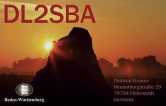My proof-of-concept works pretty stable - please check the status screen:
Here I've build an audio CW-filter based on the circuit from NM0S/4SQRP.
This filter works pretty well. I've done some audio analysis using a cheap soundcard from BEHRINGER and the shareware application AUDIOTESTER.
Now I've finished the Audio CW-filter I've decribed here in details.
Hier eine Sammlung unserer Wanderungen/Ausflüge der vergangenen Jahre
Based on the work of John, M0UKD, I've build a small sensor-keyer. I used a surplus aluminium shelf and two aluminium stand-offs as "paddles".
See the evolution of this project here.
Lorem ipsum dolor sit amet, consectetur adipiscing elit, sed do eiusmod tempor incididunt ut labore et dolore magna aliqua. Ut enim ad minim veniam, quis nostrud exercitation ullamco laboris nisi ut aliquip ex ea commodo consequat. Duis aute irure dolor in reprehenderit in voluptate velit esse cillum dolore eu fugiat nulla pariatur. Excepteur sint occaecat cupidatat non proident, sunt in culpa qui officia deserunt mollit anim id est laborum.
This was my first participation in the WAG contest since 2010 - and I must say, it was a pleasure!
I managed to complete 472 QSOs all in CW :-)
I've planned to sell my ELECRAFT K2 so I placed some adds in the various HAM sources and I found a buyer willing give my K2 a new home.
Fortunately I decided to do a quick check on the K2 functions, to be sure, that the buyers receives a full functional K2.
I did the check in the late afternoon on 80m and I was shocked - strong stations can be received every 7kHz. Testing the transmitter shows a totally unstable RF signal.
Some weeks ago I've build a full-featured XPhase for my father, DK1UO. He is sometimes affected by heavy interference from Plasma-TVs or similar scrap
The function of the XPhase is based on the fact that the interfering signal, received by an auxiliary antenna, is added phase-shifted to the signal received from the main antenna. When the phase-shift is more or less 180°, the interfering signal is canceled out.
My XPhase is based on the work of Hanns, DK9NL. A commercial versions can be found here under the name QRM-Eliminator. Google will provide you some futher informations.
I've ordered the LF-converter BX-082 kit from the German HAM Radio magazine FUNKAMATEUR already some months ago and now found the time to build and test it.
It all started with an article in the issue July 2014 of the German amateur radio magazine FUNKAMATEUR. Martin Kumm, DC3MKB published in this issue an interesting article for a smart SMD soldering station based on the well know ARDUINO UNO.
In this post, I've showed, how to setup Mosquitto on an Windows 8 machine. Now let me describe, howto connect an Arduino via Ethernet to the running Mosquitto MQTT broker.
After my first experiments with 2elemtry, I decided to give MOSQUITTO a try. Mosquitto is a small MQTT message broker, which provides basically the same functionality like 2lemetry.
Here the steps, I got Mosquitto up und running on my Windows 8 machine:
During my researches for my home automation project I also stumbled across the MQTT protocol for sensor-server-communication. A matching arduino library was found quickly here on Nick's blog. An arduino sketch was quickly copied from here and modified. Download my version from here.
Für den ersten nanoKeyer habe ich mir zwar das Original-Gehäuse gekauft, aber der Einfachheit halber eine simple Alu-Fronplatte genommen. So richtig schick war die auf Dauer nicht. Es wurde langsam Zeit, dass er noch eine schöne Frontplatte bekommt.
The electronics for my capacitive (water) level sensor is described here. In this article I will go a little bit in depth regarding the sensor reading and value compensation.
This is the second PCB I've developed. It is an arduino-shield for my home automation project. It is also devoped using CADSoft EAGLE and was produced by PCB-Devboards in Germany.
The hardware for the MODBus master is mounted on DIN-rails inside a cheap installation box.
The MODBUS-slave with the capacitive water level sensor is now mounted inside a die cast aluminium case.
